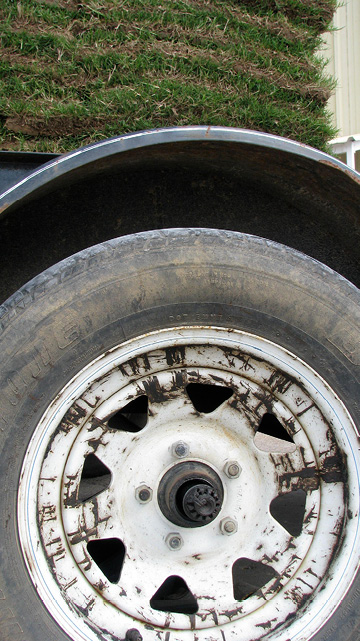Sod Installation and Maintenance
The fastest way to establish turfgrass is from sod. However, before undertaking a renovation, you should be familiar with the time and resource commitments required. This guide will help ensure that your turf is successful and healthy for years to come.
Before You Buy
1. How much sod do you need?
Using a tape measure or surveying wheel, figure out how many square feet will be needed. Make sure to subtract the area of your home and non-turf landscaping. There are several smartphone applications that may help you measure your lawn. It’s always a good idea to buy approximately 5 percent more sod than you think you’ll need. Sod may be bought in square feet or square yards. One square yard equals 9 square feet. A pallet of sod may range in size but typically contains 450 to 500 square feet. Sod may also be bought as big rolls, but these require special application equipment.
2. What type grass?
There are more than a few considerations at play when deciding what turf to plant. For some, the most critical factor is cost. For others, suitability to shade or foot traffic is more important. For an in-depth review of turf types, see Extension Publication 1322 Establish and Manage Your Home Lawn. Remember, no turf will grow in complete shade. In Mississippi, south of Highway 82 down to the Gulf Coast, St. Augustinegrass is the most shade-tolerant grass available (needs approximately 4 hours of direct sunlight or a full day of intermittent sunlight). Tall fescue may be an option for shaded scenarios in cooler climates of the Midsouth; however, fall reseeding is sometimes advised for turf to persist. Both zoysiagrass and bermudagrass grow throughout the Midsouth. For moderate shade, zoysia is slightly more shade-tolerant (needs approximately 6 hours of sunlight) than bermudagrass or centipedegrass (both need almost 8 hours of direct sunlight). Centipedegrass generally persists best south of the Tennessee border, but it is frequently found in cemeteries and other low-maintenance lawns throughout cooler climates of the Midsouth.
3. When is the best time to lay sod?
Professionals lay sod year-round unless the ground is frozen or the fields are too wet to harvest. Warm and dry weather require supplemental irrigation. Cooler temperatures are usually accompanied by timely rainfall and less evaporation, which reduce the need for irrigation. Most warm-season grasses, such as bermuda, zoysia, centipede, and St. Augustine, are dormant during the winter, but they still can be installed with adequate planning. Tall fescue should be installed in the fall or winter months to give it the best chance to survive the coming summer heat and humidity.
4. Prepare the site.
Before you buy sod, make sure your soil is prepared and that irrigation is available on-site (this is especially important when installing during dry or hot periods). Fresh-cut sod has a short shelf life, and it is not sold with enough topsoil to sustain it for more than a few days. Neither will it tolerate sitting on a pallet for very long. Complete your site preparation before the sod is delivered.
Soil test. A professional soil analysis costs less than $20 and reveals underlying issues that may affect the success of your turf. pH is the relative acidity or alkalinity of soil. The ideal pH range is different for every grass species. Follow the soil test recommendations for adjusting pH if needed. pH lower than 6 should be amended with lime. Soil test results will also include recommendations about the addition of other macro-nutrients, such as phosphorus and potassium, if they are needed. Nitrogen is typically the most limiting nutrient for plant health and should be applied routinely for most grasses. Most soil tests do not analyze for soil nitrogen; rather, you should follow N recommendations for the turf species you are planting. Typical nitrogen recommendations range from 1 pound of actual nitrogen per 1,000 square feet per growing month for bermudagrass and tall fescue, to less than one-fourth of a pound of actual nitrogen per 1,000 square feet per growing month for centipedegrass.
To get an accurate soil test, you must collect a representative sample from your lawn. Using a shovel or soil-sampling probe, systematically excavate five to ten subsamples of an area in your lawn. A depth of approximately 3 to 5 inches will be adequate. Remove the living and dead plant material by crumbling the soil. Put the separated soil material in a container for it to dry. Submit a generous cup sample to your local county Extension office or commercial soil-testing lab.
Multiple soil tests may be useful for distinguishing between good and bad areas of a lawn. If multiple tests are to be submitted, collect from areas that are most similar for one sample. For instance, a lawn may vary due to slope, soil properties (always dry or always wet), or grass stand density (as long as it is unrelated to shade).
Kill the existing turf and weeds. Sod establishes best over bare ground. Before installing new turf, it is a good idea to eradicate existing weeds and turf with a nonselective herbicide like glyphosate (Round-up), then till them under with a garden tiller or similar tool. It is critical that you follow labeled restrictions for turf herbicides in order to avoid injury to newly established turf. Make sure to avoid application of preemergence herbicides that may inhibit establishment of turf. Most homeowner products lack soil residual longer than 2 or 3 months, but commercially available products can last much longer. Talk with a lawn care professional or Extension agent if you’re planning to renovate an area and need help determining the best strategy.
Remove debris. This is the best time to remove debris left behind from construction. It may be necessary to do this again during the next step after preparing the soil.
Amending the soil. Using a tiller or renovating tool, prepare the soil. Ensure that surface drainage moves away from permanent structures and that there are no low spots that will impound water. This is an opportunity to incorporate nutrient-rich compost and recommended lime. Composts are the preferred amendment to loosen heavy clay soils. Incorporate 25 to 50 percent compost by volume. To amend the top 3 inches of a soil, you need to incorporate 1 to 2 inches of compost to give you a 4-inch root zone. If a deeper root zone is required, more compost will be needed. Fertilizers do not have to be added before laying the sod, but it is not a bad idea. Soil amendments need only be incorporated in the top 6 to 10 inches where turf roots grow.
5. Where do I buy sod?
Like most produce, the freshest and most affordable sod is locally grown. Organizations such as Turf Producers International and the Mid-South Turf Council maintain a list of producers in the Southeast.
Most sod farms sell to landscapers and homeowners alike. If you only need a small area of sod, your local nursery should be able to sell it by the piece. For larger areas, sod is generally sold as on-farm pick-up or delivery. Delivery fees are often a flat rate within a certain radius of the farm, with an additional mileage rate beyond that. Surcharges for pallets and big roll cores are common. If you choose to pick up your sod at the farm, make sure to have an adequate vehicle and/or trailer. Always ensure proper tire pressure and that tires are in good condition (Figure 1). A 450-square-foot pallet of sod may weigh as much as a ton. Also, make sure to take ratchet straps and a tarp to properly secure your load.

6. Laying the sod.
When possible, space pallets around the site so you won’t have to carry sod very far. If pallets will not be laid immediately, place them in shaded areas, and keep them lightly moistened to prevent desiccation and overheating.
It is not unusual for sod to have a yellow tinge when kept on a pallet. This does not mean it has expired. Sod purchased during winter months lasts longer on the pallet than during summer months.
When laying squares or rolls, it is important to stagger ends (Figure 2). Erosion potential is greatest in straight lines, so it is especially important to avoid creating straight channels oriented down a slope. It is best to orient the first row of sod being installed along a straight edge, such as a street, or parallel to the front of the home. Save trimming and edging for last. Use a straight edged shovel or machete.

7. Water immediately.
A common question is, “How long should I wait before I water?” During the summer months, the answer is: Don’t wait to water! Someone should be watering newly installed sod while others lay it (Figure 3). Professionals will often wet the soil lightly before any sod has been laid.
An advantage to laying during cooler months is that less water is required. If laid during the spring, natural rainfall may need be supplemented only occasionally with irrigation.
During warmer or drier months, there is no rule of thumb for how much water to apply. Sod should never turn bluish-gray, which indicates it is not moist enough. But water should also not be running into the surrounding streets. A sprinkler is only adequate when it is moved often to ensure complete coverage. Hand watering while checking for moist soil beneath the sod is the best technique.

“How long should I continue to water?” is another common question. A general rule of thumb is that, for the first week, soil should be soft underfoot but not oozing wet. More than one irrigation event may be required per day during the heat of summer, but remember: turf roots need oxygen, too. Sometimes the best monitor for moisture is a screwdriver. If the soil is dry, it will be tough to push the screwdriver all the way to the handle. If properly moist, the screwdriver should be cool or even moist when removed—like checking to see if a cake is baked!
As root growth is initiated, sod will start to “tack down” within a week during peak growing conditions. After that first week, daily irrigation should suffice. Soil should be moist to the touch but not so muddy or soft that you can’t walk across it. After 2 to 3 weeks, irrigation can be limited to every other day. Without sufficient moisture, turf will begin to wilt and turn bluish-gray. This should be the ultimate deciding factor for how much water to apply.
Once established, a healthy lawn is fairly resilient. In the Southeast, timely rainfalls usually mean we don’t have to irrigate more than once per week. Too much irrigation is wasteful and actually encourages diseases, weeds, and pest problems. If irrigation is required and rainfall is not in the 48-hour forecast, no more than 1 inch of water per week is required. Use pie pans or tuna cans to calibrate your irrigation system to deliver the right amount of water within a set time.
8. Mowing and routine maintenance.
It is rarely necessary to mow sod immediately after installation. Routine mowing can resume as soon as necessary, but, if watered appropriately, soil may be too soft and susceptible to tracking. Other routine events, such as fertilization and pest control, should only be conducted where product recommendations do not exclude use on newly established grasses. For instance, many herbicides used for preemergence weed control may cause unacceptable injury to young sod. For more information, see Extension Publication 1322 Establish and Manage Your Home Lawn.
The information given here is for educational purposes only. References to commercial products, trade names, or suppliers are made with the understanding that no endorsement is implied and that no discrimination against other products or suppliers is intended.
Publication 2951 (POD-04-22)
By Jay McCurdy, PhD, Associate Professor, and Barry Stewart, PhD, Professor, Plant and Soil Sciences.
The Mississippi State University Extension Service is working to ensure all web content is accessible to all users. If you need assistance accessing any of our content, please email the webteam or call 662-325-2262.




